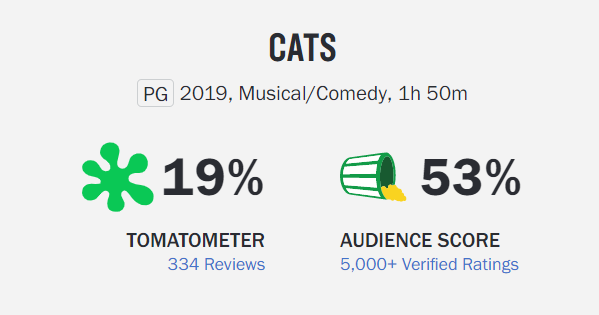THE DECLINE OF GOOD FILMS
The downward spiral of movie quality in years past

Photo courtesy of Rotten Tomatoes
Cats (2019) critic and audience review.
The much loved artform of cinema has changed greatly over time, and in recent years it seems to be on a decline. A lack of new ideas in the filmmaking industry, as well as the take over of streaming services are some of the many causes for this degenerating trend of well-made movies.
The movies of the last few years are comprised of quick and action packed shots that easily satisfy people’s ever shortening attention spans; however their plotlines leave much to be desired. The innovation seen in movies decades previous is rarely seen today. Take, for example, Orson Welles Citizen Kane, a movie created in 1941 that was widely considered the best movie of all time for multiple decades (MOVIEWEB). This film was regarded as such because of a serious amount of creativity. Welles created shots never before seen and wrote the film from perspectives that were mind boggling to audiences. “Orson Welles told the story of Charles Foster Kane through multiple point-of-view segments from the people who knew Kane best, refracted through a non-linear narrative” (MOVIEWEB). Movies before Citizen Kane were told start to finish, but this one was not, it jumped back and forth in time. Welles was able to introduce a concept never explored before in cinema captivating audiences. He also played with new editing techniques using the green screen and montages, both often used in movies today (MOVIEWEB). The effects this film has had on the movie making industry are still discussed, but most movies made recently have had nowhere near the same impact.
The innovation seen
in movies decades
previous is rarely
seen today.
A big reason for this is what seems to be a drought of inventiveness. Numerous movies made today do not shock viewers. Depending on the genre, there are hundreds of different clichés to be used by any given filmmaker. One example might be a romantic comedy where the two main characters pretend to be dating until they fall in love. Or what about a heist movie with a group of misfits that work together to steal the ultimate prize. These plot ideas lack any flavor; they’re boring and overused. Despite this, there are movies coming out constantly that follow these exact threads. To add onto these tired storylines it is rare today to see a movie with new and intriguing framing or unique camera techniques.
Quentin Tarantino, a highly accoladed film director and writer, is known for his visually interesting movies and overall creative storytelling. One cinematography tactic he is known for using in a number of his films is the low-angle trunk shot. A self explanatory approach, the camera is angled facing upwards from the trunk of a car (Premium Beat). The shot doesn’t even involve a car sometimes, the point is that the camera faces the actors from below to give the appearance of the viewer looking up at them. This application is far from difficult to imagine, but it is intriguing to the eye. Plenty of directors nowadays do not seem to consider explorative angles like this.
Directors like Tarantino are also known for a special type of mark or signature in their movies. For Tarantino this happens to be feet. Oddly enough, in most of his films there is a shot with feet in frame, broadly displayed. This may seem out of place, but it is one way Tarantino puts his “watermark” on a movie. Another example would be Wes Anderson, a well known director, who has a very distinct signature style. Anderson films his movies using visual symmetry. As opposed to using the rule of thirds to naturally break up what’s on screen Anderson directly centers his shots on one point (SCREENRANT). If you paused his movies frame by frame you could almost split each one perfectly in half based upon the point of focus. Now, not all directors do this, in fact many don’t, but the point is that little things like this make movies all that much more interesting. Adding small stylistic choices to just half of the movies that have come out in the past decade would greatly improve what feels like a downhill slope of compelling films. Tarantino himself has even remarked that we are in one of the worst movie experiencing eras of all time; along with the 1950’s and 80’s (People).
An additional idea that may be contributing to this slump of satisfactory movies is the popularization of streaming services. Platforms like Netflix, HBO Max, and Hulu are all bigger than ever and have almost completely dominated the moviegoing game. It is currently easier than ever to watch a movie from the comfort of your own home. Many people debate whether these services are actually helpful or harmful to the film industry. In many ways it could be considered both. These platforms allow for a more broad access to films from all over the world. They also tend to be cheaper than physically going to the theater; seeing as you can pay a small monthly fee or a larger amount of money for a one use ticket. Both of these things are positive influences, but streaming also has its flaws.
Netflix is one of the most dominant streaming services of all time. It’s so large that it has dived head-first into the movie making pool. “Netflix has produced over 1,500 originals. In other words, these newer streaming services are now challenging long-upheld studios, like Warner Bros” (The Dartmouth). Netflix now being able to offer easy movie going and creating films of its own works perfectly for the company itself. However, this is damaging to pre-existing studios as mentioned before. Traditionally a studio would spend years working on a film and release it to theaters hoping for positive box office reviews. Netflix, though, can make a movie in a matter of months and, whether or not it is a success, they have a huge monthly income from their subscribers. This means that the streaming service is able to make quick, cheap, and unoriginal films and roll them out at a startlingly fast pace. With how easily accessible they are, it’s no surprise that many movies people are watching lately are these same Netflix films.
Now, this is not all to say that not a single good movie has been made in the last decade. There have been plenty of noteworthy films to hit the screen in the last few years (Parasite, Moonlight, Nomadland, for example).
The number just seems to have decreased since years past. Cinema is an ever changing artform and it is beautiful. Hopefully, as time goes on this trend will end and movies will be art again.

"I think it pisses God off when you walk by the color purple in a field somewhere and don't notice it" (Alice Walker).







